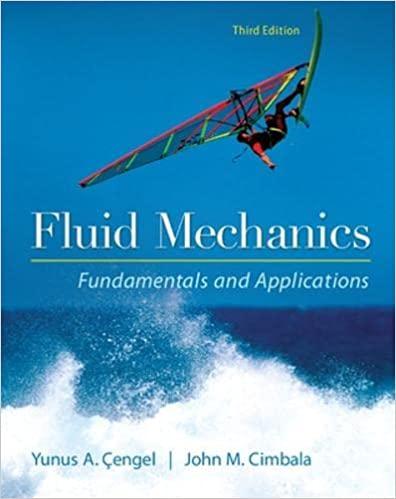Calculate and compare the efficiency of the two turbines of Prob. 14156. They should be the same
Question:
Calculate and compare the efficiency of the two turbines of Prob. 14–156. They should be the same since we are assuming dynamic similarity. However, the larger turbine will actually be slightly more efficient than the smaller turbine. Use the Moody efficiency correction equation to predict the actual expected efficiency of the new turbine. Discuss.
Data from Problem 14-156
Experiments on an existing turbine (A) yield the following data: DA = 86.0 cm, HA =22.0 m,V̇A = 69.5 m3/s, ρA = 998.0 kg/m3, ṅA = 240 rpm, bhpA = 11.4 MW. You are to design a new turbine (B) that has the following requirements: ρB = 998.0 kg/m3, HB = 95.0 m, and ṅB = 210 rpm. Apply the computer program you developed in Prob. 14–155 to calculate DB (m), V̇B (m3/s), and bhpB (MW). Also calculate the turbine specific speed. What kind of turbine is this (most likely)?
Data from Problem 14–155
Develop a general-purpose computer application (using EES or other software) that employs the affinity laws to design a new turbine (B) that is dynamically similar to a given turbine (A). The inputs for turbine A are diameter, net head, capacity, density, rotational speed, and brake horsepower. The inputs for turbine B are density (ρB may differ from ρA), available net head, and rotational speed. The outputs for turbine B are diameter, capacity, and brake horsepower. Test your program using the following inputs: DA = 1.40 m, HA = 80.0 m, V̇A = 162 m3/s, ρA = 998.0 kg/m3, ṅA = 150 rpm, bhpA = 118 MW, ρB = 998.0 kg/m3, HB = 95.0 m, and ṅB = 120 rpm. Verify your results manually.
Step by Step Answer:

Fluid Mechanics Fundamentals And Applications
ISBN: 9780073380322
3rd Edition
Authors: Yunus Cengel, John Cimbala





